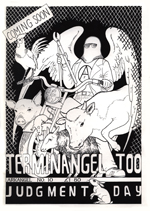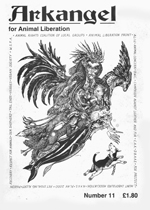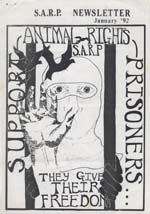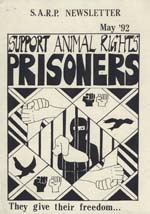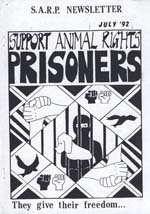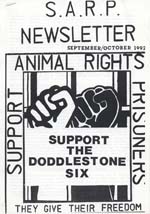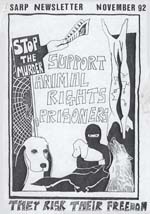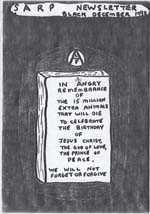The Archives
-
Arkangel, Periodicals
Arkangel #10-11
07.03.14 | PermalinkArkangel #10-11 (1993-1994. London, England.)
The early 1990s were a tumultuous time for the movement in England. Hunters began hiring professional security services to beat and harass saboteurs, the violence became so extreme that when Tom Worby was murdered by a hunt masters vehicle, the hunters nearby laughed and mocked his death. The hopefulness of the 1980s was fading away, and campaigners were becoming more hardened, which in turn led to a decline in public support as groups like the Justice Department began sending out small mail bombs. Many organizations were mired in infighting over strategy and issues of class and race. And then there was the problem of repression. Scotland Yard’s Animal Rights National Index had gathered detailed profiles on over 21,000 animal liberationists by 1990, and their spying on the movement was only set to intensify.
Through it all a dedicated core of individuals forged ahead and took animals from places of abuse, educated others about the plight of non-humans, and spread the message of compassionate action across oceans and artificial borders. Arkangel tells the story, and we are happy to continue our posting of the complete set here on TALON.
…
-
Campaign newsletters, Periodicals
Support Animal Rights Prisoners Newsletters: Year Two
07.30.13 | PermalinkS.A.R.P. Newsletter #6-11 (1992 – Northampton, England)
One of the big frustrations of working on the TALON site is that the materials we archive contain so much information it becomes difficult to organize and contextualize it all. Our posting of the Barry Horne SARP newsletter revival has made this sense of frustration more distinct than ever.
1992 was an eventful year for the movement: Mike Hill was murdered by hunter Alan Summersgill, the Doddlestone six were arrested protesting that murder, in North America Darren Thurston was arrested, Ronnie Lee was released, Kieth Mann was on remand and just about to escape from prison… This is just the tip of the iceberg as far as the significant events that took place over twelve long months twenty one years passed. We could spend pages discussing how these incidents shaped the future, how recent revelations about police informants in the UK have changed our understanding of old arrests, and so on. Unfortunately there is no time to pull at all of these strings- but the SARP newsletters certainly will provide inquisitive readers with many threads of their own to pull. From details of Operation Fox to “Laugh Along with the ALF,” each newsletter if filled with intriguing bits of our collective history.
…
-
Campaign newsletters, Periodicals
Support Animal Rights Prisoners newsletters: Year One.
06.17.13 | PermalinkS.A.R.P. Newsletter #1-5 (1991 – Northampton, England)
After a brief existence and quick demise in the 1980’s, the Support Animal Rights Prisoners organization was re-founded by Barry Horne and some friends in 1991. At the time Barry was imprisoned for possession of incendiary devices, but he never let incarceration keep him from participation in the movement. So, using a prison typewriter, he set to work writing the SARP newsletters. There are claims in the first issue that the material in SARP was written by a committee of five volunteers, but information we have received from reliable sources suggest that in actuality Barry wrote every issue of SARP except for the final issue, which was written by ALF Press Officer Robin Webb.
Barry was one of the most dedicated activists our struggle has ever known, but it would be a disservice to him to strip him of his humanity by pretending that he was without error. There are some poorly examined ideas in the pages of SARP that deserve measured critique, most especially that animal rights activists must, in all instances, preserve “unity.” Calls for unity are often used by those guilty of the most destabilizing behaviors as a way to avoid criticism for their own complicity in pushing people apart. During the era that SARP was being published there were concerted efforts by organized racists to join the movement, for car and postal bombings to be supported, and so on. Under such conditions total unity wouldn’t exactly be a good thing, right?
But for every weak idea presented in the pages of SARP, there are also beautiful moments that give voice to our imprisoned comrades, that remember our dead, and that call for nothing less than a revolution to liberate non-humans from the tyranny of the human species. Barry wrote with an intensity and single minded dedication that reminds us of just how precious each second spent fighting is, and how we must stop wasting those ticks of the clock. To Barry, life, and even death, should be utilized battling the scourge of speciesism. These newsletters are Barry’s voice ringing out from decades past, telling us to ACT NOW in solidarity with the animal nations.
…
-
Periodicals
Facklan
10.11.12 | PermalinkFacklan (1996-1997 Umea, Sweden)
(Editors note: Facklan is a Swedish language publication that we bring to you due to its historical significance. Umea, Sweden produced one of the most remarkable animal liberation communities of the 1990s. Their influence was so strong that politicians in Sweden stated in national media that they feared animal rightists may collapse the countries infrastructure, both through sabotage and the conversion of the nations youth to veganism. Facklan was produced during the infancy of this tiny, but formidable uprising. One of our readers from Sweden has offered the summary that follows.)
Facklan (The Torch) was a Swedish magazine supporting the A.L.F. and
other radical groups fighting for the animals. It was released in four
issues in 1996-1997, during the biggest peak of A.L.F. activity in the
1990:ies in Sweden. The magazine was based in the northern city Umea,
which was well known for it’s number of vegans and animal rights
activists, militant (all fur shops closed in Umea as a result of the
A.L.F.) as well as non militant (almost 50 percent of the students at
some schools were vegetarians). Umea was often referred to as the
“Vegan Mecca”, and was also well known for bands promoting the animal
rights message, such as Refused.The first issue contained translated interviews etc from mainly UK and
US sources, and also had copied text from the Swedish militant
activist/anarchist manual Lila Svarta. Of course there was also a
diary of actions and addresses to imprisoned animal rights activists.
Two spreads were also dedicated to show mainstream media articles from
the time, also serving as a sign of the impact of the A.L.F. activity.During the later issues, more of the content was produced by Swedish
authors. In the second issue, there were a lot of more news from
Sweden and Finland, letters to the editor, communiques from the newly
started group The Wild Minks, a report from the riot against the fur
auction in Skara, a piece on the repression of Umea acitivists,
reviews of records under the headline “Activist Core”, and now also a
diary of actions focusing on Sweden. Content from abroad was still
used though, this time information from The Final Nail and on Barry
Horne. On the last page, a summary in English was also published for
the foreign readers.The third issue contained an exclusive interview with The Wild Minks,
the group that got most feared among the fur farmers, for liberating
minks and setting fire to properties of the fur industry. An address
list to all Swedish fur farms was published together with slogans such
as “What are you waiting for?”. There were critical articles directed
to hardcore posers, as well as articles about how animals that had
been liberated were doing in their new homes.The fourth and the last issue contained more articles like “How the
Raid was Done” – often raids that the police had said were so
professional it had to have been carried out by professionals from
abroad… One person urges for a Swedish A.L.F. Supporters Group, and
a spokesperson who could defend the actions openly. Til now, this had
only been done my anonymous activists in balaclavas, or by Emelie
E:son, an anonymous A.L.F. activist from the 1980:ies. Focus was also
targeted on groups trying to attack Peter Singer (who was at a visit
in Sweden during this period), there was a big report from the animal
rights campaigning and activity against the vivisection at the Umea
University, as well as more information directly from The Wild Minks.After the last issue, a Swedish A.L.F. Supporters Group was founded,
doing both work towards the media as towards prisoners and the animal
rights movement in general. They also released their own magazine,
later named Befriaren (The Liberator).



